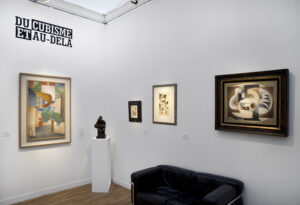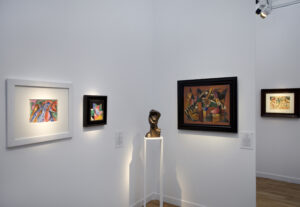For the 2019 edition of the FIAC, the Le Minotaure gallery is offering an exhibition around the Golden Section, this branch of Cubism freed from the solutions of the “Kahnweiler stable” often limiting the movement to the sole names of Braque and Picasso .
Following in the footsteps of the organizers of the three legendary Salons of the Section d’Or – taking place in 1912, 1920 and 1925 – we would like to present the diversity of approaches that artists such as the Delaunay couple, Frantisek Kupka, Amédée Ozenfant, Louis Marcoussis, Serge Férat, Léopold Survage or Henri Valensi or Georges Valmier, could have had cubism in the 1910s and 1920s. It was within the Salon – and within the framework of members’ meetings at the Duchamp brothers in Puteaux – that these artists were able to discuss and exhibit their works, often rejected by official salons; it is there that Marcel Duchamp presented his Nude Descending the Staircase refused to the Independents; that Kahnweiler discovered Juan Gris; and that the Delaunays presented their compositions later baptized by Guillaume Apollinaire as orphiques.
U SPORTS Football Bookmakers: Betlama’s Best Options for Canadian University Football
Are you a die-hard fan of Canadian university football? Do you find yourself glued to the TV or stadium seats, cheering on your alma mater’s team with every fiber of your being? If so, you’re not alone. U SPORTS football has a dedicated following across the country, with fans eagerly awaiting each game day. But what if you could add an extra layer of excitement to your viewing experience? Enter the world of online sports betting, where you can put your knowledge and passion to the test while potentially earning some extra cash.
In this article, we’ll delve into the realm of U SPORTS football bookmakers, specifically focusing on Betlama, a trusted and reputable online sportsbook. We’ll explore the various betting options available, from moneyline bets and point spreads to over/under wagers and prop bets. Whether you’re a seasoned bettor or a newcomer to the scene, we’ll provide you with valuable insights and strategies to help you make informed decisions. Get ready to elevate your game day experience and potentially cash in on your football expertise!
The Rise of U SPORTS Football Betting in Canada
Canadian university football has a dedicated following, and Betlama offers a fantastic platform for fans to engage with the action through betting. With a wide range of markets available for U SPORTS football games, Betlama provides numerous opportunities to showcase your knowledge and potentially earn some extra cash. Whether you’re a seasoned bettor or a newcomer to the world of sports gambling, Betlama’s user-friendly interface and comprehensive coverage make it an excellent choice.
One of the standout features of Betlama’s U SPORTS football offerings is the variety of betting options available. From traditional moneyline and point spread bets to more specialized wagers like player props and game totals, there’s something for every type of bettor. Additionally, Betlama’s competitive odds ensure that you’re getting the best possible value for your bets. With live in-game betting and a wealth of statistical data at your fingertips, you can make informed decisions and capitalize on the ever-changing dynamics of each game.
Betlama’s Comprehensive Coverage of U SPORTS Football
U SPORTS football bookmakers offer a thrilling way to engage with the exciting world of Canadian university football. Among the top options, Betlama stands out as a premier destination for fans and bettors alike. This trusted platform provides a seamless and user-friendly experience, catering to the unique needs of those who follow the U SPORTS football scene.
Betlama’s comprehensive coverage of U SPORTS football events ensures that bettors never miss an opportunity to wager on their favorite teams. From regular season games to highly anticipated bowl matchups, the platform offers a wide range of betting markets, allowing you to explore various betting options and strategies. Whether you’re a seasoned bettor or a newcomer to the world of sports betting, Betlama’s intuitive interface and detailed game insights make it easy to navigate and make informed decisions.
One of the standout features of Betlama is its competitive odds and attractive promotions. The platform consistently offers competitive odds across all U SPORTS football events, ensuring that bettors can maximize their potential winnings. Additionally, Betlama frequently runs exciting promotions and bonuses, providing added value and enhancing the overall betting experience. These promotions may include free bets, enhanced odds, or special offers tailored specifically to U SPORTS football enthusiasts.
Furthermore, Betlama prioritizes security and fair play, ensuring a safe and trustworthy environment for its users. With robust security measures in place and a commitment to responsible gambling practices, bettors can enjoy the thrill of U SPORTS football betting with peace of mind. Whether you’re cheering on your alma mater or simply appreciating the skill and passion of university-level football, Betlama offers a comprehensive and reliable platform to elevate your experience.
Competitive Odds and Promotions for U SPORTS Football Bettors
For Canadian university football fans seeking the ultimate betting experience, Betlama stands out as the premier destination. This online sportsbook offers a comprehensive range of U SPORTS football betting options, catering to both seasoned and novice bettors alike. With their user-friendly platform and competitive odds, Betlama ensures an engaging and rewarding wagering journey.
One of the standout features of Betlama’s U SPORTS football offerings is the variety of bet types available. From the traditional moneyline and point spread bets to more intricate options like player props and game parlays, there’s something to suit every bettor’s preferences. Additionally, Betlama’s live in-game betting feature allows you to capitalize on real-time developments, adding an extra layer of excitement to your wagering experience.
What truly sets Betlama apart is their commitment to providing exceptional customer service and a secure betting environment. Their knowledgeable support team is available around the clock to address any queries or concerns, ensuring a seamless and enjoyable betting journey. Furthermore, Betlama employs state-of-the-art security measures to safeguard your personal and financial information, allowing you to focus solely on the thrill of the game.
User-Friendly Interface and Mobile Compatibility
U SPORTS, formerly known as Canadian Interuniversity Sport (CIS), is the national governing body for university sports in Canada. Among the various sports it oversees, football remains a popular and thrilling spectacle. For fans and bettors alike, the U SPORTS football season provides ample opportunities to engage with the action and potentially profit from their knowledge and insights.
When it comes to betting on U SPORTS football, Betlama emerges as a standout option. This online sportsbook caters specifically to Canadian bettors, offering a comprehensive range of betting markets and competitive odds for U SPORTS football games. Whether you’re a seasoned bettor or a newcomer to the world of sports betting, Betlama’s user-friendly platform and extensive resources make it an attractive choice.
One of the key advantages of using Betlama for U SPORTS football betting is the variety of betting options available. From traditional moneyline and point spread bets to more intricate prop bets and futures, Betlama covers all bases. You can wager on individual games, conference championships, or even the coveted Vanier Cup, Canada’s university football national championship game. Additionally, Betlama offers live in-game betting, allowing you to capitalize on real-time developments and adjust your strategy accordingly.
Furthermore, Betlama prioritizes the safety and security of its users. With robust encryption protocols and stringent verification processes, you can rest assured that your personal and financial information is well-protected. The platform also provides comprehensive guides, statistics, and analysis to help you make informed betting decisions. Whether you’re a die-hard U SPORTS football fan or simply seeking an exciting betting experience, Betlama’s commitment to excellence makes it a top choice for Canadian university football bookmakers.
Responsible Gambling Practices and Security Measures
U SPORTS, formerly known as Canadian Interuniversity Sport (CIS), is the national governing body for university sports in Canada. Football is one of the most popular and highly anticipated events in the U SPORTS calendar, with teams from across the country competing for the coveted Vanier Cup. For avid sports bettors, U SPORTS football offers an exciting opportunity to wager on their favorite teams and players.
Betlama, a leading online sportsbook, provides a comprehensive range of betting options for U SPORTS football enthusiasts. With competitive odds, a user-friendly interface, and a wide variety of markets, Betlama stands out as one of the best choices for Canadian university football betting. Whether you’re a seasoned bettor or new to the world of sports wagering, Betlama offers a seamless and enjoyable experience.
One of the standout features of Betlama’s U SPORTS football offerings is the diverse range of betting markets available. From moneyline bets and point spreads to over/under totals and prop bets, there’s something for every type of bettor. You can wager on individual games, conference championships, or even the prestigious Vanier Cup itself. Additionally, Betlama offers live in-game betting, allowing you to capitalize on real-time developments and adjust your bets accordingly.
Betlama’s commitment to providing a secure and trustworthy betting environment is another key advantage. With state-of-the-art encryption and robust security measures in place, you can rest assured that your personal and financial information is protected at all times. Furthermore, Betlama offers a variety of convenient payment options, including credit cards, e-wallets, and cryptocurrencies, making it easy to fund your account and withdraw your winnings. With excellent customer support available around the clock, you can enjoy a seamless and hassle-free betting experience.
With the U SPORTS football season in full swing, Canadian university football fans have plenty of opportunities to get in on the action with Betlama’s comprehensive betting options. From moneyline and spread bets to game and player props, Betlama offers a diverse range of markets to cater to every level of sports bettor. Whether you’re a seasoned veteran or a newcomer to the world of sports betting, Betlama’s user-friendly platform and competitive odds make it an ideal choice for those looking to add an extra layer of excitement to their U SPORTS football viewing experience.
A set of works by Serge Férat (part of the steering committee of the 1920 Section, also being its treasurer) and Léopold Survage (a leading figure in the 2nd Section) will represent the Russian artists of the Golden Section as well as the the adventure of Soirées de Paris, an avant-garde literary magazine founded by Apollinaire and financed by the fortune of Baroness d’Oettingen (alias François Angiboult, present as a painter at the Section’s exhibitions). We will exhibit, among others, one of Survage’s “Colorful Rhythms” which testifies to the interest that many painters in the group, such as Kupka or Valensi, had for the links between painting and music.
Valensi played an important role in the Golden Section, as an organizer and collaborator, from its first edition. His paintings demonstrate the original evolution of Cubism towards Orphic abstraction and the desire of artists linked to the Salon to add movement, color and music to the more orthodox solutions of analytical Cubism.
To evoke other cubists present at the Section d’Or and on the Parisian (international) scene of the period, we will present paintings by the Russian Baranoff-Rossiné, the Hungarian Josef Csaky), the Polish Louis Marcoussis, Fernand Léger, or still by Amédée Ozenfant, the father of purism, as well as a series of gouaches by Frantisek Kupka.



